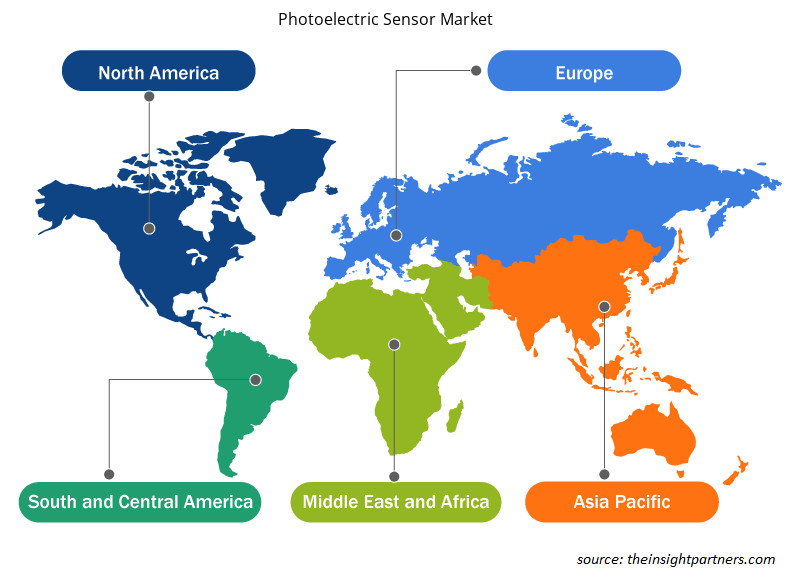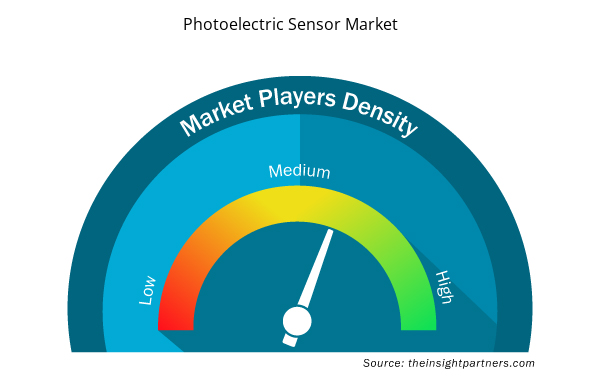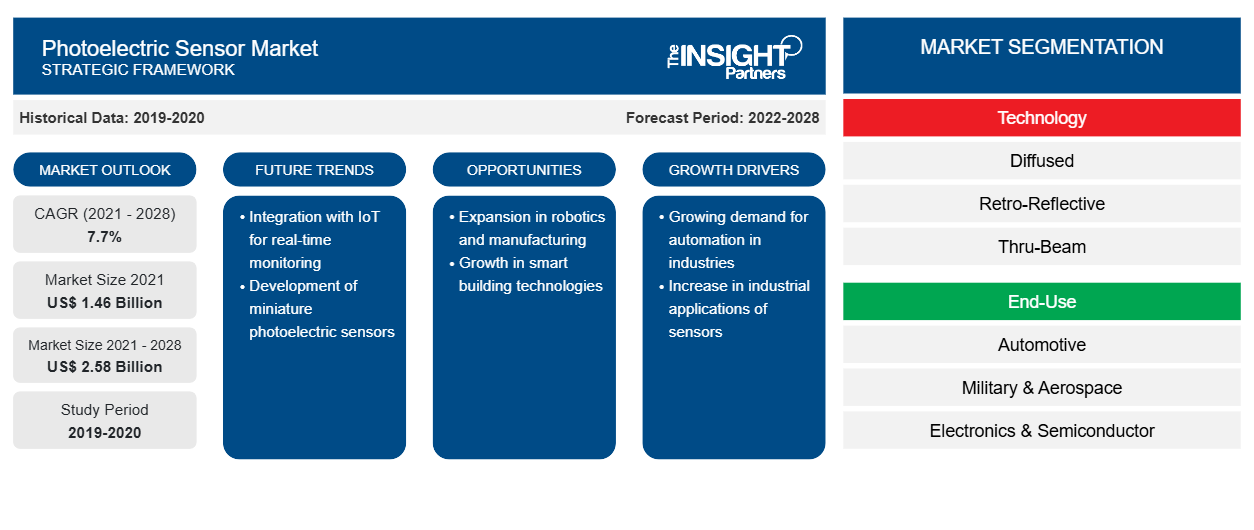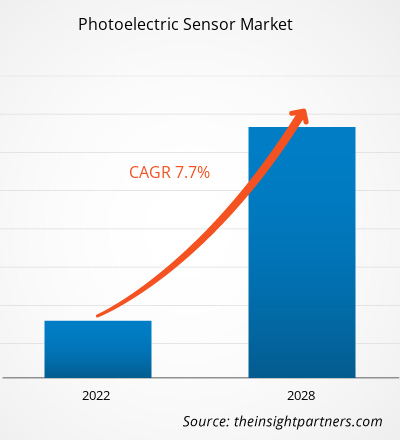[Rapporto di ricerca] Il mercato dei sensori fotoelettrici è stato valutato a 1.458,23 milioni di dollari nel 2021 e si prevede che raggiungerà i 2.577,56 milioni di dollari entro il 2028; si prevede che crescerà a un CAGR del 7,7% dal 2021 al 2028.
I sensori fotoelettrici stanno guadagnando popolarità grazie alla loro elevata affidabilità e alle capacità di rilevamento degli oggetti a lungo raggio, indipendentemente dalle dimensioni, dalla forma, dal colore, dal materiale e dalle proprietà superficiali degli oggetti. Questi sensori sono progettati per funzionare in condizioni difficili; inoltre, sono dotati di tecnologie avanzate per garantire una soppressione affidabile di riflessi indesiderati. Queste capacità li rendono più versatili di molti altri tipi di sensori e adatti all'uso industriale. Ad esempio, i sensori retroriflettenti con filtri di polarizzazione rilevano la posizione di un carrello di qualsiasi forma e materiale, che deve essere mantenuto dentro e fuori dai binari di un ottovolante . Inoltre, i sensori fotoelettrici sono ampiamente utilizzati nei settori militare e aerospaziale grazie alla loro elevata precisione e alle prestazioni affidabili. Sono utilizzati negli aerei cargo per il rilevamento di fumo e incendi. Inoltre, i sensori fotoelettrici aiutano i produttori di cellule e motori a monitorare i parametri del sistema aerospaziale come pressione, temperatura, accelerazione, posizione ottica e velocità. Inoltre, l'industria della difesa sta utilizzando ampiamente apparecchiature di rilevamento biologico per rilevare la presenza di sostanze chimiche nell'ambiente e per valutare il rischio di potenziali minacce biologiche rilevando materiali biologici nocivi, per salvaguardare sia le popolazioni militari che quelle civili. Pertanto, l'accuratezza e l'affidabilità delle operazioni dei sensori fotoelettrici li rendono un tipo di sensore preferito in condizioni industriali difficili.
Impatto della pandemia di COVID-19 sul mercato dei sensori fotoelettrici
Secondo l'ultimo rapporto dell'Organizzazione Mondiale della Sanità (OMS), Stati Uniti, Spagna, Italia, Francia, Germania, Regno Unito, Russia, Turchia, Brasile, Iran e Cina sono tra i paesi più colpiti dall'epidemia di COVID-19. Nel 2020, l'economia mondiale ha subito conseguenze significative e si prevede che gli effetti persisteranno in una certa misura negli anni a venire. L'epidemia ha sconvolto settori primari come l'elettronica, i semiconduttori e la produzione. Un forte calo della crescita di questi settori sta limitando la crescita del mercato dei sensori fotoelettrici . Chiusure di fabbriche, divieti di viaggio e commercio e blocchi delle frontiere per combattere e contenere l'infezione hanno avuto un impatto negativo sulla produzione, la fornitura e le vendite di vari prodotti di sensori.
Personalizza questo report in base alle tue esigenze
Riceverai la personalizzazione gratuita di qualsiasi report, comprese parti di questo report, o analisi a livello nazionale, pacchetto dati Excel, oltre a usufruire di grandi offerte e sconti per start-up e università
- Scopri le principali tendenze di mercato in questo rapporto.Questo campione GRATUITO includerà analisi di dati che spaziano dalle tendenze di mercato alle stime e alle previsioni.
I produttori di sensori fotoelettrici si stanno concentrando sulla riduzione dei costi operativi per rimanere competitivi. Tuttavia, si prevede che riprenderanno le attività di produzione durante la fase post-lockdown . Si prevede che le iniziative governative per stimolare le economie e gli allentamenti nei lockdown alimenteranno la domanda di sensori fotoelettrici durante il periodo di previsione. È probabile che la domanda di sensori fotoelettrici si espanda man mano che le nuove tecnologie vengono adottate più ampiamente nei settori automobilistico e aerospaziale.
Approfondimenti sul mercato dei sensori fotoelettrici
La crescente domanda di sensori fotoelettrici nel settore farmaceutico stimola la crescita del mercato dei sensori fotoelettrici
Le aziende farmaceutiche si concentrano sul miglioramento delle loro operazioni di produzione complessive evitando discrepanze come imballaggi vuoti, che possono essere causati dalla mancata disponibilità di compresse di medicinali sulla linea di produzione. Il settore sta sempre più implementando sensori fotoelettrici per il conteggio delle compresse, il riempimento di flaconi e la verifica del conteggio (negli studi clinici). Questi sensori vengono utilizzati anche nelle macchine automatiche per l'evasione delle prescrizioni presso farmacie al dettaglio e ospedali. Inoltre, i progressi nei sensori fotoelettrici in termini di portata di rilevamento, che sta migliorando la loro accuratezza di conteggio, insieme al mantenimento di ambienti di produzione igienici escludendo i contatti umani durante il confezionamento dei medicinali sono i vantaggi associati ai sensori fotoelettrici. Inoltre, il sensore fotoelettrico fornisce una soluzione conveniente, che si ottiene tramite una linea di produzione automatica nel settore farmaceutico. Quindi,
l'aumento dell'adozione di sensori fotoelettrici nelle aziende farmaceutiche è principalmente attribuito alla loro capacità di migliorare l'efficienza, ridurre i costi operativi del settore e facilitare il monitoraggio della produzione in tempo reale. Questi sensori automatizzano i livelli superiore e inferiore della misurazione del liquido in un barattolo o in un serbatoio. L'uso di sostanze chimiche fortemente corrosive (acide o basiche) è comune nelle aziende farmaceutiche e, quindi, il rilevamento dei livelli del liquido nei serbatoi di stoccaggio è un compito importante in questi impianti. Pertanto, un uso crescente di sensori fotoelettrici nell'industria farmaceutica guiderebbe la crescita del mercato dei sensori fotoelettrici nei prossimi anni.
Approfondimenti di mercato basati sulla tecnologia
In base alla tecnologia, il mercato dei sensori fotoelettrici è segmentato in diffuso, retroriflettente e sbarrante. Nel 2020, il segmento retroriflettente ha rappresentato la quota maggiore del mercato.
Approfondimenti di mercato basati sull'utente finale
In base all'utente finale, il mercato dei sensori fotoelettrici è segmentato in automotive, militare e aerospaziale, elettronica e semiconduttori, packaging e altri. Nel 2020, il segmento automotive ha rappresentato la quota di mercato maggiore.
Gli operatori che operano nel mercato dei sensori fotoelettrici adottano strategie quali fusioni, acquisizioni e iniziative di mercato per mantenere le loro posizioni nel mercato. Di seguito sono elencati alcuni sviluppi da parte degli operatori chiave:
- Ad aprile 2020, Balluff Photoelectric Sensors ha fornito dati di monitoraggio delle condizioni. Il portafoglio di sistemi di automazione e monitoraggio intelligenti (SAMS) include rilevamento fotoelettrico solido, monitoraggio delle condizioni e tecnologie IO-link avanzate, tutte pensate per risparmiare tempi di fermo semplificando la risoluzione dei problemi, il cambio e la configurazione della macchina.
- Nel febbraio 2020, la Eaton Corp plc è stata inserita nella lista delle aziende più ammirate al mondo nel 2020 dalla rivista Fortune.
Approfondimenti regionali sul mercato dei sensori fotoelettrici
Le tendenze regionali e i fattori che influenzano il mercato dei sensori fotoelettrici durante il periodo di previsione sono stati ampiamente spiegati dagli analisti di Insight Partners. Questa sezione discute anche i segmenti e la geografia del mercato dei sensori fotoelettrici in Nord America, Europa, Asia Pacifico, Medio Oriente e Africa e Sud e Centro America.

- Ottieni i dati specifici regionali per il mercato dei sensori fotoelettrici
Ambito del rapporto di mercato sui sensori fotoelettrici
| Attributo del report | Dettagli |
|---|---|
| Dimensioni del mercato nel 2021 | 1,46 miliardi di dollari USA |
| Dimensioni del mercato entro il 2028 | 2,58 miliardi di dollari USA |
| CAGR globale (2021 - 2028) | 7,7% |
| Dati storici | 2019-2020 |
| Periodo di previsione | 2022-2028 |
| Segmenti coperti | Per tecnologia
|
| Regioni e Paesi coperti | America del Nord
|
| Leader di mercato e profili aziendali chiave |
|
Densità degli attori del mercato: comprendere il suo impatto sulle dinamiche aziendali
Il mercato dei sensori fotoelettrici sta crescendo rapidamente, spinto dalla crescente domanda degli utenti finali dovuta a fattori quali l'evoluzione delle preferenze dei consumatori, i progressi tecnologici e una maggiore consapevolezza dei vantaggi del prodotto. Con l'aumento della domanda, le aziende stanno ampliando le loro offerte, innovando per soddisfare le esigenze dei consumatori e capitalizzando sulle tendenze emergenti, il che alimenta ulteriormente la crescita del mercato.
La densità degli operatori di mercato si riferisce alla distribuzione di aziende o società che operano in un particolare mercato o settore. Indica quanti concorrenti (operatori di mercato) sono presenti in un dato spazio di mercato in relazione alle sue dimensioni o al valore di mercato totale.
Le principali aziende che operano nel mercato dei sensori fotoelettrici sono:
- Società Autonica
- Balluff GmbH
- Società Eaton
- Ifm Elettronica GmbH
- Società Keyence
Disclaimer : le aziende elencate sopra non sono classificate secondo un ordine particolare.

- Ottieni una panoramica dei principali attori del mercato dei sensori fotoelettrici
Il mercato globale dei sensori fotoelettrici è stato segmentato come indicato di seguito:
Per tecnologia
- Diffuso
- Retroriflettente
- Trave passante
Da parte dell'utente finale
- Automobilistico
- Militare e aerospaziale
- Elettronica e semiconduttori
- Confezione
- Altri
Per Geografia
- America del Nord
- NOI
- Canada
- Messico
- Europa
- Francia
- Germania
- Italia
- Regno Unito
- Russia
- Resto d'Europa
- Asia Pacifico (APAC)
- Cina
- India
- Corea del Sud
- Giappone
- Australia
- Resto dell'APAC
- Medio Oriente e Africa (MEA)
- Sudafrica
- Arabia Saudita
- Emirati Arabi Uniti
- Resto del MEA
- America del Sud (SAM)
- Brasile
- Argentina
- Resto del SAM
Profili aziendali
- Società Autonica
- Balluff GmbH
- Società Eaton
- Ifm Elettronica GmbH
- Società Keyence
- Società OMRON
- Azienda: Rockwell Automation
- Società Panasonic
- MALATO AG
- Schneider Electric Italia
- Analisi storica (2 anni), anno base, previsione (7 anni) con CAGR
- Analisi PEST e SWOT
- Valore/volume delle dimensioni del mercato - Globale, regionale, nazionale
- Industria e panorama competitivo
- Set di dati Excel


- E-Bike Market
- Aircraft MRO Market
- Hand Sanitizer Market
- 3D Mapping and Modelling Market
- Trade Promotion Management Software Market
- Electronic Signature Software Market
- Sweet Potato Market
- Parking Management Market
- Medical and Research Grade Collagen Market
- Quantitative Structure-Activity Relationship (QSAR) Market

Report Coverage
Revenue forecast, Company Analysis, Industry landscape, Growth factors, and Trends

Segment Covered
This text is related
to segments covered.

Regional Scope
North America, Europe, Asia Pacific, Middle East & Africa, South & Central America

Country Scope
This text is related
to country scope.
Domande frequenti
The rising need for of sensors and technological developments to solve complex challenges is encouraging innovations in photoelectric sensors. The pulse ranging technology (PRT), which can calculate object’s distance by using the principal of direct light propagation time measurement method, can be valuable in commercial industrial applications. PRT sensors provide accurate and continuous distance data with digital or analog outputs. In addition, positioning PRT sensors on each side of the carton and measuring these distances would also provide dimensions of pallets or cartons, which can be used to calculate the volume of the pallet or carton. The technology is expected to further improve the efficiency and accuracy of line assembly by providing comprehensive details of materials in production or operational process.
The growth of the Photoelectric Sensor market is primarily attributed to the accuracy and reliability of photoelectric sensors. Photoelectric sensors are gaining popularity due to their high reliability and long-range object detection capabilities, irrespective of the size, shape, color, material, and surface properties of objects. These sensors are designed to operate under harsh conditions; moreover, they are enabled with advanced technologies to ensure reliable suppression of undesirable reflections. These abilities makes them more versatile than many other sensor types and appropriate for industrial usage.
Rising demand for photoelectric sensors in pharmaceuticals industry is providing noteworthy opportunities to the Photoelectric Sensor market players. Pharmaceutical companies focus on improving their overall manufacturing operations by avoiding discrepancies such as empty packaging, which can be caused due to the unavailability of medicine tablets on the production line. The industry is increasingly deploying photoelectric sensors for tablet counting, bottle filling, and count verification (in clinical trials). These sensors are also being used in automated prescription fulfillment machines at retail pharmacies and hospitals.
Trends and growth analysis reports related to Electronics and Semiconductor : READ MORE..
The List of Companies - Photoelectric Sensor Market
- Autonics Corporation
- Balluff GmbH
- Eaton Corporation plc
- Ifm Electronic GmbH
- Keyence Corporation
- OMRON Corporation
- Rockwell Automation, Inc.
- Panasonic Corporation
- SICK AG
- Schneider Electric SE
The Insight Partners performs research in 4 major stages: Data Collection & Secondary Research, Primary Research, Data Analysis and Data Triangulation & Final Review.
- Data Collection and Secondary Research:
As a market research and consulting firm operating from a decade, we have published and advised several client across the globe. First step for any study will start with an assessment of currently available data and insights from existing reports. Further, historical and current market information is collected from Investor Presentations, Annual Reports, SEC Filings, etc., and other information related to company’s performance and market positioning are gathered from Paid Databases (Factiva, Hoovers, and Reuters) and various other publications available in public domain.
Several associations trade associates, technical forums, institutes, societies and organization are accessed to gain technical as well as market related insights through their publications such as research papers, blogs and press releases related to the studies are referred to get cues about the market. Further, white papers, journals, magazines, and other news articles published in last 3 years are scrutinized and analyzed to understand the current market trends.
- Primary Research:
The primarily interview analysis comprise of data obtained from industry participants interview and answers to survey questions gathered by in-house primary team.
For primary research, interviews are conducted with industry experts/CEOs/Marketing Managers/VPs/Subject Matter Experts from both demand and supply side to get a 360-degree view of the market. The primary team conducts several interviews based on the complexity of the markets to understand the various market trends and dynamics which makes research more credible and precise.
A typical research interview fulfils the following functions:
- Provides first-hand information on the market size, market trends, growth trends, competitive landscape, and outlook
- Validates and strengthens in-house secondary research findings
- Develops the analysis team’s expertise and market understanding
Primary research involves email interactions and telephone interviews for each market, category, segment, and sub-segment across geographies. The participants who typically take part in such a process include, but are not limited to:
- Industry participants: VPs, business development managers, market intelligence managers and national sales managers
- Outside experts: Valuation experts, research analysts and key opinion leaders specializing in the electronics and semiconductor industry.
Below is the breakup of our primary respondents by company, designation, and region:

Once we receive the confirmation from primary research sources or primary respondents, we finalize the base year market estimation and forecast the data as per the macroeconomic and microeconomic factors assessed during data collection.
- Data Analysis:
Once data is validated through both secondary as well as primary respondents, we finalize the market estimations by hypothesis formulation and factor analysis at regional and country level.
- Macro-Economic Factor Analysis:
We analyse macroeconomic indicators such the gross domestic product (GDP), increase in the demand for goods and services across industries, technological advancement, regional economic growth, governmental policies, the influence of COVID-19, PEST analysis, and other aspects. This analysis aids in setting benchmarks for various nations/regions and approximating market splits. Additionally, the general trend of the aforementioned components aid in determining the market's development possibilities.
- Country Level Data:
Various factors that are especially aligned to the country are taken into account to determine the market size for a certain area and country, including the presence of vendors, such as headquarters and offices, the country's GDP, demand patterns, and industry growth. To comprehend the market dynamics for the nation, a number of growth variables, inhibitors, application areas, and current market trends are researched. The aforementioned elements aid in determining the country's overall market's growth potential.
- Company Profile:
The “Table of Contents” is formulated by listing and analyzing more than 25 - 30 companies operating in the market ecosystem across geographies. However, we profile only 10 companies as a standard practice in our syndicate reports. These 10 companies comprise leading, emerging, and regional players. Nonetheless, our analysis is not restricted to the 10 listed companies, we also analyze other companies present in the market to develop a holistic view and understand the prevailing trends. The “Company Profiles” section in the report covers key facts, business description, products & services, financial information, SWOT analysis, and key developments. The financial information presented is extracted from the annual reports and official documents of the publicly listed companies. Upon collecting the information for the sections of respective companies, we verify them via various primary sources and then compile the data in respective company profiles. The company level information helps us in deriving the base number as well as in forecasting the market size.
- Developing Base Number:
Aggregation of sales statistics (2020-2022) and macro-economic factor, and other secondary and primary research insights are utilized to arrive at base number and related market shares for 2022. The data gaps are identified in this step and relevant market data is analyzed, collected from paid primary interviews or databases. On finalizing the base year market size, forecasts are developed on the basis of macro-economic, industry and market growth factors and company level analysis.
- Data Triangulation and Final Review:
The market findings and base year market size calculations are validated from supply as well as demand side. Demand side validations are based on macro-economic factor analysis and benchmarks for respective regions and countries. In case of supply side validations, revenues of major companies are estimated (in case not available) based on industry benchmark, approximate number of employees, product portfolio, and primary interviews revenues are gathered. Further revenue from target product/service segment is assessed to avoid overshooting of market statistics. In case of heavy deviations between supply and demand side values, all thes steps are repeated to achieve synchronization.
We follow an iterative model, wherein we share our research findings with Subject Matter Experts (SME’s) and Key Opinion Leaders (KOLs) until consensus view of the market is not formulated – this model negates any drastic deviation in the opinions of experts. Only validated and universally acceptable research findings are quoted in our reports.
We have important check points that we use to validate our research findings – which we call – data triangulation, where we validate the information, we generate from secondary sources with primary interviews and then we re-validate with our internal data bases and Subject matter experts. This comprehensive model enables us to deliver high quality, reliable data in shortest possible time.


 Ottieni un campione gratuito per questo repot
Ottieni un campione gratuito per questo repot